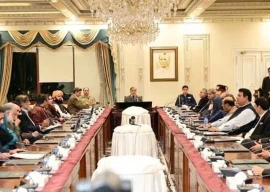
“Should we decorate the wall with them,” scoffed one of the judges.
After a summer of bloody violence in 2011, the Supreme Court took suo motu action and made a slew of recommendations. The administration had a year to implement them. But it has so far been unable to satisfy the court that it made all the changes that were needed to bring down Karachi’s crime rate. The maps are an important part of the picture as land grabbing, turf wars and encroachments on state land are slowly eating away at law and order.
Last October, the court had recommended the Board of Revenue survey state lands. But on Thursday, 13 months later, its officers stood in court and said they could not complete the task. They added, however, that they did have a database of existing records.
“Are you opening a new Pandora’s Box,” asked Justice Gulzar Ahmed. Why are revenue officers not paying visits to the land? He referred to the pile of cases coming to the high court challenging forged land record entries. What was the point in a database, if one record showed eight to ten owners?
The Karachi Metropolitan Corporation maps were met with similar frowns. The city’s Iftikhar Qaimkhani produced an old digital map of Karachi’s towns instead of an updated one with political or ethnic divisions as the court had said.
He went on to tell the court perhaps what it already knew, that Karachi was divided into five districts, 18 towns and was spread over 3,500 square kilometres with 1,400 square kilometres populated. He said that the Sindh government was responsible for developing potential land, which must be surveyed and records of unregistered state lands should also be maintained.
Justice Anwar Zaheer Jamali said the unregistered lands were the main reason behind the land grabbing business, which was rampant in the suburbs of Karachi and a serious factor in the deteriorating law and order conditions.
This is not the first time a court has taken up a record of state land. In 2005, the Sindh High Court had ordered a survey of all unregistered lands in province, but it has not yet been done, said Advocate General Abdul Fateh Malik. He placed the blame at the finance department’s doorstep as it had lost the paperwork with the chief minister’s approval in the middle. He hastened to add, however, that they had just found it the day before and the survey would be conducted within six months as proposed by the revenue department.
Justice Amir Hani Muslim remarked that everything would be alright once four officers from the revenue department were jailed.
“The court’s order to survey land has not been followed even after seven years, because you want the status quo to continue and the land-grabbing to thrive,” said Justice Jamali. “Why should the officers not be charged with contempt of court as all sitting and retired officers are equally responsible.”
Justice Hani pointed out that it was not a senior member of the Board of Revenue, but the Sindh government and Sindh chief secretary who should be charged with contempt of court, as the directions were issued to the Sindh government and thus the CS was supposed to implement them.
Taking serious view of the state of affairs, the court issued show-cause notices to the Sindh chief secretary, senior member of the BoR, a senior member of the KMC Master Plan office and other land department officers - either serving or retired - to explain why they should not be held in contempt for not following the 2005 orders.
KMC was told to submit a working formula to end land grabbing.
Justice Gulzar observed that it was important to not only provide people security but also spaces for recreation. There must be spaces for children to play and the elderly to visit. All such spots located in Kharadar and downtown have been sold, he mentioned.
For their part, the law enforcement authorities were able to produce their maps of the city showing how the police force had been divided. IG Fayyaz Leghari explained that according to a recent overhaul, Karachi now has 20 districts, each supervised by a Police Superintendent. (Karachi has 110 police stations, according to its website.)
Provincial Election Commission office Attaur Rehman also filed a report on their point of view on the de-limitation of constituencies in Karachi. He was directed to submit a report on why the work had not been done under the De-limitation of Constituencies Act 1974.
Published in The Express Tribune, October 26th, 2012.






























-(1)1714378140-0/AliAminMaryam-(4)-(1)1714378140-0-270x192.webp)

1714370039-0/ojwilson-(1)1714370039-0-270x192.webp)







COMMENTS
Comments are moderated and generally will be posted if they are on-topic and not abusive.
For more information, please see our Comments FAQ